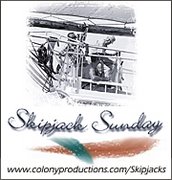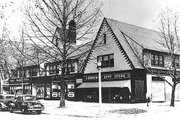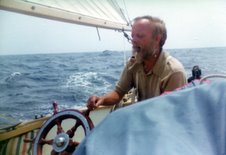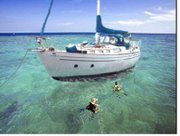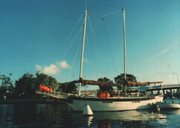There is oil on the water in the Gulf of Mexico and it is not hard to get rid of a huge amount of it. As a kid I played on a creek near Baltimore that had an almost continual sheen of oil on it's surface coming from Nearby Industry. The creek had become barren of fish, crabs and sea weed. Natures way of cleaning the water was for dust and pollen to land on the water and roll with the wavelets. As these particles roll in the water they keep adding a thin layer of oil that is the sheen on the water. The particle grows in size and continues to increase in size, from then on. These we called grease balls. They were a kind of emulsion formed by a combination of water and oil. I have seen these balls as big as 6" in diameter with many more in smaller sizes. Any dust that will float will roll up into these balls cleaning the surface of the water.
A powder could be spread on the Gulf. It might be saw dust, or wood sanding dust. It might be micro balloons. Any round particulate that can roll freely will pick up oil. Maybe a few tractor trailer loads of the material would be a good test. There is likely a best size and shape for this and a little research would certainly determine that.
These grease balls will roll up into marsh grass and on beaches. They will not kill birds or fish as they harden on the surface in sunlight. They need not get to shore as they can be dredged up in nets and sent to refineries for processing. Because oil floats these balls will float no matter how big they get These nodules will be working day and night at cleaning the waters surface and the operating cost is zero, zilch, nothing. The value of the crude will not be lost when refined. I would think a shrimper might make a pretty good days wages by dredging up grease balls and selling them to the refineries. Everybody wins. Doug Pollard
Of Mooncursers and other Spun Yarns
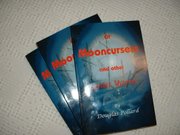
Click the link below and visit my Book site
Of Mooncursers and other spun yarns
Thursday, June 17, 2010
Gulf oil spill may not lastas long as we think
Bear Creek east Of Baltimore Md. always had a layer of oil on it. It leaked from settling ponds of local industry. The creek was basically dead. A few crabs lived at the mouths of drainage ditches as did small fish but that was about all the life there was. All the beds of sea Grass had died. It was a dead little sea. In the late 1940's a major polluter found itself in a labor dispute and on strike and shut down. The creek came alive with amazing speed. In three weeks there was some fish in the creek. In six weeks there where a lot of fish as well as crabs. The had moved in from the bay and though not exactly thriving they were living in the creek. Local residents of the area were amazed to be catching rock-fish, croaker, white perch and spot. Taylor blues were breaking the water feeding on plentiful alewives. You could drag up a net with enough grass shrimp for a days fishing. Waterman who had them, put their shedding pots back in the water and sold soft crabs again. To the mixed feelings of all who were glad to be going back to work the fishing was not to last. As the manufacturing started up anew and the water was ever more streaked with oil, fish floated on their sides.And lined the banks.
I think this shows that a body of water can repair itself pretty quick when the pollution stops. This true of oil pollution but some things are longer lasting. I think the Gulf will recover quickly as soon as the oil can be removed from the water. My solution of rolling particles on the water will not likely remove the heavy oil but it will take that long lasting sheen that lingers after a spill. This sheen damages the coast line for a long time after
I think this shows that a body of water can repair itself pretty quick when the pollution stops. This true of oil pollution but some things are longer lasting. I think the Gulf will recover quickly as soon as the oil can be removed from the water. My solution of rolling particles on the water will not likely remove the heavy oil but it will take that long lasting sheen that lingers after a spill. This sheen damages the coast line for a long time after
Gulf Oil Spill
There is oil on the water in the Gulf of Mexico and it is not hard to get rid of a huge amount of it. As a kid I played on a creek near Baltimore that had an almost continual sheen of oil on it's surface coming from Nearby Industry. The creek had become barren of fish, crabs and sea weed. Natures way of cleaning the water was for dust and pollen to land on the water and roll with the wavelets. As these particles roll in the water they keep adding a thin layer of oil that is the sheen on the water. The particle grows in size and continues to increase in size, from then on. These we called grease balls. They were a kind of emulsion formed by a combination of water and oil. I have seen these balls as big as 6" in diameter with many more in smaller sizes. Any dust that will float will roll up into these balls cleaning the surface of the water.
A powder could be spread on the Gulf. It might be saw dust, or wood sanding dust. It might be micro balloons. Any round particulate that can roll freely will pick up oil. Maybe a few tractor trailer loads of the material would be a good test. There is likely a best size and shape for this and a little research would certainly determine that.
These grease balls will roll up into marsh grass and on beaches. They will not kill birds or fish as they harden on the surface in sunlight. They need not get to shore as they can be dredged up in nets and sent to refineries for processing. Because oil floats these balls will float no matter how big they get These nodules will be working day and night at cleaning the waters surface and the operating cost is zero, zilch, nothing. The value of the crude will not be lost when refined. I would think a shrimper might make a pretyy good days wages by dredging up grease balls and selling them to the refineries. Everybody wins. Doug Pollard
Posted by Doug at 11:13 AM 0 comments Links to this post
Labels: clean that oil sheen, income for Gulf States waterman, oil on the water, oil sheen, oil spill. save the marshes from oil, rolling up oil, saving crude oil off the water, turn spilled crude to money
Home
Subscribe to: Posts (Atom)
A powder could be spread on the Gulf. It might be saw dust, or wood sanding dust. It might be micro balloons. Any round particulate that can roll freely will pick up oil. Maybe a few tractor trailer loads of the material would be a good test. There is likely a best size and shape for this and a little research would certainly determine that.
These grease balls will roll up into marsh grass and on beaches. They will not kill birds or fish as they harden on the surface in sunlight. They need not get to shore as they can be dredged up in nets and sent to refineries for processing. Because oil floats these balls will float no matter how big they get These nodules will be working day and night at cleaning the waters surface and the operating cost is zero, zilch, nothing. The value of the crude will not be lost when refined. I would think a shrimper might make a pretyy good days wages by dredging up grease balls and selling them to the refineries. Everybody wins. Doug Pollard
Posted by Doug at 11:13 AM 0 comments Links to this post
Labels: clean that oil sheen, income for Gulf States waterman, oil on the water, oil sheen, oil spill. save the marshes from oil, rolling up oil, saving crude oil off the water, turn spilled crude to money
Home
Subscribe to: Posts (Atom)
Subscribe to:
Posts (Atom)
